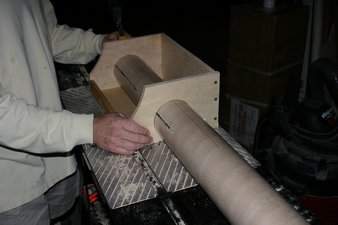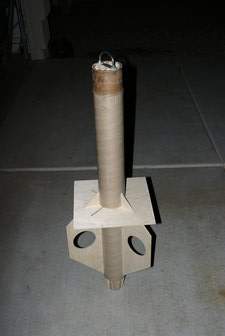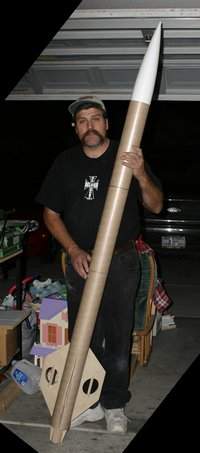DG&A High Power Rocketry Defender
DG&A High Power Rocketry - Defender {Kit}
Contributed by Billy Dahlberg and Osgood Conklin
| Manufacturer: | DG&A High Power Rocketry |
Visit Rocket Team Vatsaas to enjoy their incredible rocket talents and an all around fun rocketry website!
 The Defender is one of DG&A's larger kits, measuring 87 inches in length and 4 inches in diameter. It
has three large trapezoidal fins with an unusual feature - a 3-inch hole in the center of each. It's difficult to
describe in words, but this unusual design attribute really sets this model apart from other three-fins-and-a-nose-cone
rockets. The Defender also incorporates the unique finned-nozzle found on other DG&A models, just like the even
larger DG&A Armageddon.
The Defender is one of DG&A's larger kits, measuring 87 inches in length and 4 inches in diameter. It
has three large trapezoidal fins with an unusual feature - a 3-inch hole in the center of each. It's difficult to
describe in words, but this unusual design attribute really sets this model apart from other three-fins-and-a-nose-cone
rockets. The Defender also incorporates the unique finned-nozzle found on other DG&A models, just like the even
larger DG&A Armageddon.
I didn't expect good news when I saw the box holding the Defender high-power rocket kit. The Post Office had done it's best to fold, spindle, and mutilate the container on it's way to my house.
 Fortunately, I was relieved to find that the contents were well protected in generous amounts of packing
material. One tube had a very minor crease - but overall, I would say that SG&A had defeated the package-crushing
machines at the U.S. Postal Service.
Fortunately, I was relieved to find that the contents were well protected in generous amounts of packing
material. One tube had a very minor crease - but overall, I would say that SG&A had defeated the package-crushing
machines at the U.S. Postal Service.
After extracting the contents from the mutilated shipping container, I laid out the contents. They were well organized and easy to sort out. The components included LOC nose cone and body tubes, and cardboard couplers. The bag of recovery components came complete with a ripstop nylon parachute, nylon web harness, and all the nuts, bolts, and washers required to hold it all together.
 The couplers are cardboard and a little flimsy right out of the package. The instructions don't call for it,
but I soaked mine inside and out with thin CA to make them a little more rugged. But on the plus side, there are dozens
of cut wood pieces in this kit, many of them tiny, used in the construction of the finned nozzle and the fin details.
All of them are precision-cut and go together perfectly. The 48-inch parachute is well made, but a little dainty for
this size rocket -- so unless you're able bring in the finished rocket weight at around three pounds it's going to land
pretty hard.
The couplers are cardboard and a little flimsy right out of the package. The instructions don't call for it,
but I soaked mine inside and out with thin CA to make them a little more rugged. But on the plus side, there are dozens
of cut wood pieces in this kit, many of them tiny, used in the construction of the finned nozzle and the fin details.
All of them are precision-cut and go together perfectly. The 48-inch parachute is well made, but a little dainty for
this size rocket -- so unless you're able bring in the finished rocket weight at around three pounds it's going to land
pretty hard.
 The fins are skillfully cut from fine 1/4-inch Baltic birch plywood. The bulkheads and centering rings were
a nice, tight fit, but they were cut from lighter and softer 1/4-inch luan plywood, the stuff often used as an
underlayment in the installation of linoleum. This is probably strong enough to contain stresses from thrust -- there
are four rings and the fins are mounted to the motor tube -- but may be a little flimsy for the shock cord mount or
motor retention. I opted to make new rings out of birch. I also changed the rocket slightly to incorporate use an an
anti-zipper design. Click [HERE!] to read more about this feature. The photos on that page were taken while building
the Defender.
The fins are skillfully cut from fine 1/4-inch Baltic birch plywood. The bulkheads and centering rings were
a nice, tight fit, but they were cut from lighter and softer 1/4-inch luan plywood, the stuff often used as an
underlayment in the installation of linoleum. This is probably strong enough to contain stresses from thrust -- there
are four rings and the fins are mounted to the motor tube -- but may be a little flimsy for the shock cord mount or
motor retention. I opted to make new rings out of birch. I also changed the rocket slightly to incorporate use an an
anti-zipper design. Click [HERE!] to read more about this feature. The photos on that page were taken while building
the Defender.
Speaking of motor retention; there isn't any. The finned nozzle is a sweet visual feature but makes most traditional motor retention methods impossible. The instructions mention that you might want to plan ahead to install motor retention of your own design if friction fitting your motors doesn't appeal to you. Unfortunately, it only says so on the last page of the instruction, a little late for the warning to do you any good if you don't read the instructions all the way through before you start.
 There were a number of places where the instructions were practically unintelligible -- either
because the grammatical construction was peculiar or the technical descriptions were poorly worded or both. An email to
SG&A for clarification of a particularly confusing paragraph wasn't a lot of help because the response was no more
than a cut-and-paste passage clipped directly out of the instructions. Once the instructions were deciphered the kit
went together quite easily. The components were cut with precision. The body tube was not pre-slotted, so cutting the
fin slots was probably the most challenging construction step (which I did with the help of Brad, his router table, and
custom fin-slotting jig). I aligned the fins using the fin-jig template described [HERE!].
There were a number of places where the instructions were practically unintelligible -- either
because the grammatical construction was peculiar or the technical descriptions were poorly worded or both. An email to
SG&A for clarification of a particularly confusing paragraph wasn't a lot of help because the response was no more
than a cut-and-paste passage clipped directly out of the instructions. Once the instructions were deciphered the kit
went together quite easily. The components were cut with precision. The body tube was not pre-slotted, so cutting the
fin slots was probably the most challenging construction step (which I did with the help of Brad, his router table, and
custom fin-slotting jig). I aligned the fins using the fin-jig template described [HERE!].
 The finned nozzle was time-consuming but not difficult. This bird comes stock in a single-deployment
configuration. The instructions don't mention it, but there are plenty of couplers and joints in the design to convert
it to altimeter-based dual deployment, which I did. After priming and painting comes the application of the
computer-cut vinyl decals -- and they are really nice -- making the final rocket extremely impressive.
The finned nozzle was time-consuming but not difficult. This bird comes stock in a single-deployment
configuration. The instructions don't mention it, but there are plenty of couplers and joints in the design to convert
it to altimeter-based dual deployment, which I did. After priming and painting comes the application of the
computer-cut vinyl decals -- and they are really nice -- making the final rocket extremely impressive.
The Defender is advertised to take motors from a I211 to a K550. I did a simulation of three-pound and four-pound Defenders flying on K550s, and found that velocity is predicted to peak at about 1100 feet per second. With these large fins and an unreinforced airframe, peak velocity in the trans-sonic zone is a shred waiting to happen -- so if you're able to build the Defender light enough to return under the provided parachute you certainly don't want to fly it on a K.
 The finished Defender weighed in at 8 pounds 14 ounces fully loaded in a dual-deployment
configuration without the motor. RockSim predicted an altitude of 2490 feet on a J350 with a maximum velocity of 425
feet per second. The actual flight was just as straight and beautiful as it could be, with drogue deployment right at
apogee -- 2465 feet according to the G-Wiz MC riding inside. It returned gently under two Rocketman R7C parachutes
after a terrific boost. In this configuration a K motor flight looks very enticing.
The finished Defender weighed in at 8 pounds 14 ounces fully loaded in a dual-deployment
configuration without the motor. RockSim predicted an altitude of 2490 feet on a J350 with a maximum velocity of 425
feet per second. The actual flight was just as straight and beautiful as it could be, with drogue deployment right at
apogee -- 2465 feet according to the G-Wiz MC riding inside. It returned gently under two Rocketman R7C parachutes
after a terrific boost. In this configuration a K motor flight looks very enticing.

Visit Rocket Team Vatsaas to enjoy their incredible rocket talents and an all around fun rocketry website!
Other Reviews
- DG&A High Power Rocketry Defender By Billy Dahlberg and Osgood Conklin
The following excerpt is from "Extreme Rocketry". The intention is to allow guests to get a basic feeling about a kit. We strongly suggest that you get a copy of the referenced Extreme Rocketry and read the entire article. Inside you will find many helpful hints in construction as well as other useful information. For more information, use the link above. (Extreme ...
Related External Links
Sponsored Ads
 |
 |











